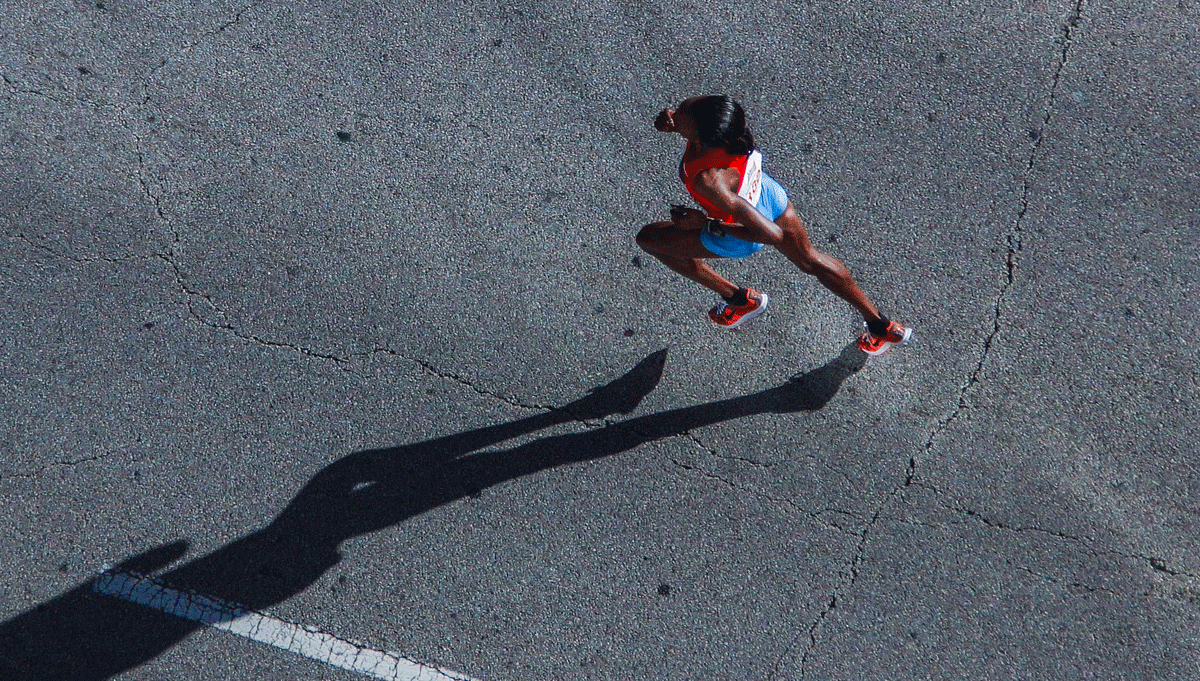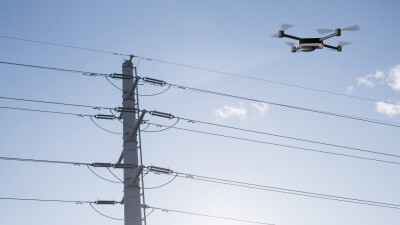Agencies like the Massachusetts Emergency Management Agency (MEMA) have taken active steps to utilize drone technology because they understand the ways in which UAVs can provide a new level of security and situational awareness. MEMA ensures the state is prepared to withstand, respond to, and recover from all types of emergencies and disasters, and they are also tasked with running the multi-agency coordination center that serves as the public safety coordination hub for the Boston Marathon. This year, drones were used by MEMA as they coordinated public safety across the eight cities and towns that the Marathon spans.
At the 2017 Boston Marathon, MEMA officials
utilized drones at key locations to transmit surveillance video to different public safety command centers. The drones were tethered and did not fly over any spectator areas, which eased the regulatory and logistical issues that otherwise would have been present for this type of usage. The drones were used because MEMA officials were able to identify and prove the real operational benefit these tools could provide.

Kurt Schwartz
Kurt Schwartz is the Executive Director at MEMA and serves as the manager of the multi-agency coordination center for the Boston Marathon. It’s a position he’s occupied for a number of years, which puts him and the agency in a central role at the Marathon. We caught up with Kurt to discuss how he got interested in UAV technology, what sort of bureaucratic logistics he had to sort through to utilize drones in this manner, how this will impact the way drones are used at future events like the Boston Marathon and plenty more.
Jeremiah Karpowicz: Can you tell us a little bit about the Massachusetts Emergency Management Agency and the sort of responsibilities you’re tasked with?Kurt Schwartz: As the state emergency management agency, our primary responsibilities are to ensure the state's preparedness to respond to and recover from all types of emergencies and disasters. During emergencies and disasters, we serve as the state's coordination point for state response and recovery activities as well as communications with the federal government in terms of federal assistance. We also serve as the single point of contact for all communities that need assistance during disasters. They work through us to get what they need, so we're very much a disaster preparedness-disaster management agency.
We also have certain responsibilities and unique missions for pre-planned events, and the Boston Marathon is the largest one. For a number of years we have served as the planning lead for multi-jurisdictional planning, and because the Marathon is a world-class event that draws 30,000 runners and up to 1,000,000 spectators, and runs through 8 different cities and towns, that ends up being a six-month planning cycle involving numerous local, state and federal agencies.
Can you talk a little bit about the approach you take for pre-planned events? Is it different than the one you take for emergencies and disasters? In pre-planned events, we spend a lot of time thinking about prevention, which is not something you think about when you're responding to an event that's already happened. Regardless of the situation, our approach to everything is about partnerships and collaboration. That's what emergency management is about.
With pre-planned events, what we do in terms of planning starts with understanding the threats and hazards, and then building plans that focus in the first instance on preventing something from occurring, and then building response plans based on reasonable worse case scenarios. As we build our response plans, we look to partners to find and commit the right types and amount of resources, and to establish interoperable communications and command and control. So some of it is similar to response, but planning for large pre-planned events is really a unique discipline.
How does the agency look at integrating or using new tools/technology like drones?We’re always open to looking at new technologies and piloting them. That's how we ended up with the two drones at this year’s Marathon. It was a pilot based on a relationship I made with CyPhy Works, when the CEO of the company attended a lecture I gave at the Harvard Kennedy School. He came up to introduce himself and told me about his company. That turned into a conversation around whether it made sense for us to use the technology at the Marathon, and that led to a series of meetings and demonstrations, which resulted in the pilot.
Very interesting to hear how that came about, although I imagine that wasn’t the most difficult part of the process. Can you talk about the administrative piece of this endeavor? Did you need to connect with city officials to get proper sign off? After having a number of conversations with CyPhy Works, they setup a demo of their tethered drone product. They put it up in the air and we played around with the camera and zoom, and we really liked it. We thought it could be a real benefit at the Marathon, particularly at the start area in Hopkinton.
I then went to the event promoter, which is the Boston Athletic Association, and to the Town of Hopkinton and the State Police and told them we had this potential pilot program, and we wanted to show the technology and its capabilities to them at another demo. After doing so, the Town of Hopkinton, the State Police, and the Boston Athletic Association said they wanted to sign on. We also had discussions with the FBI and FAA. We had to get a lot of people to sign onto this and agree that this would help us and not interfere with anything.
We spent time a lot of time on this, but it really wasn't difficult. Much of it is just about effective coordination.
You mentioned that the scale of the operation was so much larger than the exercises, and also more complex. What were some of the biggest challenges associated with this application of the technology?The logistics were actually pretty easy to set up. We did have to nail down the sites because we weren’t able to actually fly over the crowd. We had to pick the right spots where we could put these things up 400 feet and give us the right views from the camera and zooms to capture the areas we needed.
A good amount of time went into finding those locations, and then once we did we had to work out agreements with the owners of the properties, and the company had to come up with liability and insurance certificates, but again, it wasn’t all that difficult. It was just about attention to details. It was really pulled together over the course of a couple weeks.
The other logistics we had to sort through were around how to access the live feeds. The tethered drones were providing their feeds directly into a web portal, and all the company had to do was give us access credentials. We had several different command posts with those credentials watching the feeds. They operated the drones, and we just had to build the communications connection to access the web portal.
Did the fact that the drones were tethered mitigate regulatory concerns? Did you consider what it would have meant to utilize free flying drones? The tethered drones were right for us because they just went up and stayed there, so there were far less issues operationally. These drones have a very sophisticated zoom with stabilization control, so even with the winds at 400ft the pictures were great.
If they had been free flying, the flight times would have been limited and we would have been constantly going up and down. The tethered drones can stay in the air for weeks, if necessary. Also, the free flying drones are not as robust in harsh weather conditions, although it turned out we had a day without any major weather issues.
What was the reaction of the public? Did you make an effort to showcase how they would be utilized before the event?We had to look at the public information side of this, because we have messaged and continue to message that drones are not allowed along the marathon course. We had anti-drone technologies at Hopkinton to take down unauthorized drones at the same time we were using tethered drones, so we needed to figure out the best way to message that to the public. It was a no-drone zone.
We were very transparent around how we were going to be using the drones. In the two weeks leading up to the marathon, we spoke many times to the press, and during our public safety press briefings, we talked about the use of tethered drones to let the public know they were going to be there.
All in all, I think those efforts were successful because I don’t believe we had a single 911 call or complaint about our drones.
From a safety perspective, what does it mean to have that extra set of eyes in the skies?It gave the command centers and the incident commanders that much more situation awareness in terms of being able to watch the crowds and the event. They could see the movement of the people and movements of cars. When there were issues, we were able to have the drones focus on particular locations and get those views to the incident commanders. They could instantly direct troops on the ground based on what they were seeing.
We always use state police helicopters, but the helicopters are not flying at 400 ft. They're of great value to us, but the drones gave Hopkinton constant aerial surveillance of their operations. That's about seeing what's happening with 30,000 people that are packed into a village with a lot going on.
How will this impact your use of the technology moving forward? Were you satisfied with how things worked out? Absolutely. This was a very successful pilot.
I'd certainly like to see an increased use of this technology, and I know the team at CyPhy Works is already looking to address our request for making the communication between our command center and drone pilots more efficient. We used it just in Hopkinton this year, but we have many other points along the Marathon with high-density crowds where we could make really good use of aerial surveillance through drones. There's a lot more we can do with this technology, and there are lots of ways we can and want to use it.
Any advice you’d give to other emergency management officials around how they can approach utilizing drone technology in a similar manner?I think it goes back to always pushing the envelope and thinking outside the box around looking at ways to make technology work for you. You need to be careful though. There are vendors out there for everything, and in some instances we find that deploying a technology actually increases workloads and makes things more, rather than less complicated.
Our experience with this pilot was that the logistics were not difficult and the technology worked well and was easy to integrate into our existing systems. So long as they can address those integration details, public safety and emergency managers certainly should be looking to embrace drones in their everyday and disaster operations.

















Comments